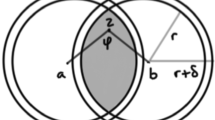Abstract
Let L be a lattice in \({\mathbb{R}^n}\). This paper provides two methods to obtain upper bounds on the number of points of L contained in a small sphere centered anywhere in \({\mathbb{R}^n}\). The first method is based on the observation that if the sphere is sufficiently small then the lattice points contained in the sphere give rise to a spherical code with a certain minimum angle. The second method involves Gaussian measures on L in the sense of Banaszczyk (Math Ann 296:625–635, 1993). Examples where the obtained bounds are optimal include some root lattices in small dimensions and the Leech lattice. We also present a natural decoding algorithm for lattices constructed from lattices of smaller dimension, and apply our results on the number of lattice points in a small sphere to conclude on the performance of this algorithm.
Similar content being viewed by others
References
Babai L.: On Lovász’ lattice reduction and the nearest lattice point problem. Combinatorica 6, 1–13 (1986)
Banaszczyk W.: New bounds in some transference theorems in the geometry of numbers. Math. Ann. 296, 625–635 (1993)
Bosma W., Cannon J., Playoust C.: The Magma algebra system. I. The user language. J. Symb. Comput. 24, 235–265 (1997)
Caire G., Damen M.O., Gamal H.E.: On maximum-likelihood detection and the search for the closest lattice point (English summary). IEEE Trans. Inform. Theory 49, 2389–2402 (2003)
Caire G., Damen M.O., Gamal H.E.: Lattice coding and decoding achieve the optimal diversity-multiplexing tradeoff of MIMO channels (English summary). IEEE Trans. Inform. Theory 50, 968–985 (2004)
Chamizo F., Iwaniec H.: On the sphere problem. Rev. Mat. Iberoam. 11, 417–429 (1995)
Cohn-Vossen S., Hilbert D.: Geometry and the Imagination. Chelsea Publishing Company, London (1999)
Conway J.H., Sloane N.J.A.: Soft decoding techniques for codes and lattices, including the Golay code and the Leech lattice. IEEE Trans. Inform. Theory 32, 41–50 (1986)
Conway J.H., Sloane N.J.A.: Sphere packings, lattices and groups. Grundlehren der mathematischen Wissenschaften 290. Springer, New York (1988)
Conway J.H., Sloane N.J.A.: On the covering multiplicity of lattices. Discret. Comput. Geom. 8, 109–130 (1992)
Delsarte P., Goethals J.M., Seidel J.J.: Spherical codes and designs. Geom. Dedic. 6, 363–388 (1977)
Fincke U., Pohst M.: Improved methods for calculating vectors of short length in a lattice, including a complexity analysis. Math. Comput. 44, 463–471 (1985)
Forney G. D.: Coset codes—part II: Binary lattices and related codes. Coding techniques and coding theory. IEEE Trans. Inform. Theory 5, 1152–1187 (1988)
Goldwasser S., Micciancio D.: Complexity of Lattice Problems, A Cryptographic Perspective. In: Springer International Series in Engineering and Computer Science, vol. 671. Springer, New York (2002).
Griess R. L. Jr.: Rank 72 high minimum norm lattices. J. Num. Theory 130, 1512–1519 (2010)
Guruswami V., Micciancio D., Regev O.: The complexity of the covering radius problem. Comput. Complex. 14, 90–121 (2005)
Heath-Brown D. R.: Lattice points in the sphere. Numb. Theory Prog. 2, 883–892 (1999)
Khot S.: Inapproximability Results for Computational Problems on Lattices.The LLL Algorithm: Survey and Applications, Chap. 14, pp. 453–473. Information Security and Cryptography, Prague (2010).
Mazo J. E., Odlyzko A. M.: Lattice points in high-dimensional spheres. Monatsh. Math. 110, 47–61 (1990)
Micciancio D., Regev O.: Worst-case to average-case reductions based on Gaussian measures. SIAM J. Comput. 37, 267–302 (2007)
Micciancio D., Voulgaris P.: Faster Exponential Time Algorithms for the Shortest Vector Problem, pp. 1468–1480. SODA, Remsen (2010).
Nebe G.: An even unimodular 72-lattice with minimum 8. J. Reine Angew. Math. http://arxiv.org/abs/1008.2862.
Quebbemann H.-G.: A construction of integral lattices. Mathematika 31, 137–140 (1984)
Tsang K.-M.: Counting lattice points in the sphere. Bull. Lond. Math. Soc. 32, 679–688 (2000)
Turyn R. J.: Hadamard matrices, Baumert-Hall units, four-symbol sequences, pulse compression, and surface wave encodings. J. Comb. Theory 16, 313–333 (1974)
Author information
Authors and Affiliations
Corresponding author
Additional information
This is one of several papers published in Designs, Codes and Cryptography comprising the “Special Issue on Coding and Cryptography”.
Rights and permissions
About this article
Cite this article
Meyer, A. On the number of lattice points in a small sphere and a recursive lattice decoding algorithm. Des. Codes Cryptogr. 66, 375–390 (2013). https://doi.org/10.1007/s10623-012-9724-0
Received:
Revised:
Accepted:
Published:
Issue Date:
DOI: https://doi.org/10.1007/s10623-012-9724-0




